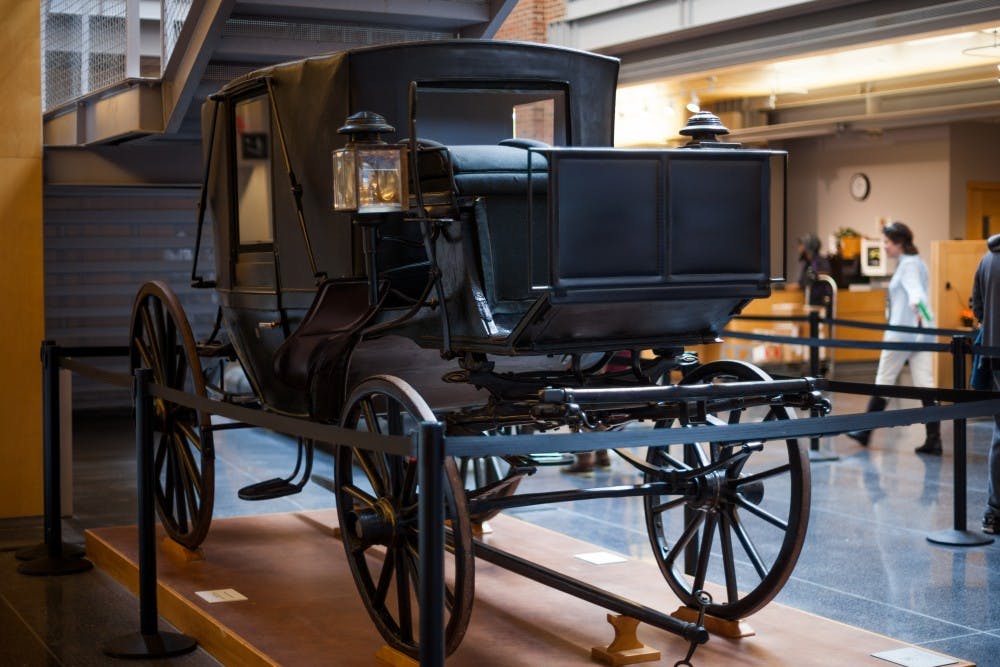When the last Empress of France needed to flee from both an invading Prussian army that had captured her husband and an angry citizen uprising engulfing Paris, she turned to her dentist.
Under fake passports, Empress Eugenie and her dentist, Philadelphia native Thomas W. Evans, escaped in Evans’ carriage, traveling to the French coast before embarking on a ship to England and safety.
Today, that carriage sits in the foyer of Penn Dental School.
According to Penn Dental School Dean Denis Kinane, Evans was one of the most influential dentists of the nineteenth century. In addition to being a pioneer in Western dentistry, Evans also maintained close relationships with Europe’s royal families in countries ranging from England to Russia. He even served as unofficial American ambassador for Emperor Napoleon III and his wife Empress Eugénie.
“He would go around to the kings and queens of Europe and talk to them about politics, about Napoleon’s views, while fixing their teeth,” Kinane said. “The best way to view Evans, I think, is a little like Benjamin Franklin, but one hundred years later.”
Despite his years mingling with the upper echelons of European society (while filling their cavities), Evans remained committed to his hometown of Philadelphia. When he died, he left his entire, vast fortune to Penn to found Penn’s dental school—now housed in the Thomas W. Evans Museum and Dental Institute.
Along with the money for the dental school, Penn also inherited the four–wheeled black Landau carriage in which Empress Eugénie and Evans escaped Paris. It stood in the school’s atrium for many years, until it was loaned to France in 1993 for what was intended to be a temporary exhibition.
But when Denis Kinane became the Dental School Dean 16 years later in 2009, he discovered that Evans’ carriage was missing. Lynn Mardsen-Atlass, the current Arthur Ross Gallery Director, came to the same conclusion: the carriage was still somewhere in France.
"It had never been returned to the University, and was never requested for return," said Mardsen–Atlass.
In July 2013, after some difficulty and "many unanswered letters," Mardsen-Atlass tracked the carriage down to the Château de Compiègne, 50 miles north of Paris. Five months later, Kinane traveled to the château to meet with the museum’s curator, armed with the legal contract confirming that Penn was the carriage’s rightful owner.
“We had a very cordial discussion, but also quite an insistent discussion, that the carriage had to come back to Pennsylvania,” Kinane said.
The mission was a success: the “Rolls Royce of its time,” as Kinane calls it, was shipped back to Penn.
Kinane arranged for Amish craftsmen in Lancaster County to help with repairs, which his own family funded in "a small [act] compared to the importance of the carriage.”
Five years later, the Dental School and the Arthur Ross Gallery partnered for a University–wide celebration to mark the return of the carriage, which coincided with the hundredth anniversary of the Dental School’s founding.
Apart from the carriage, the Dental School’s museum currently houses Evans’ impressive collection of art, jewelry, and other objects from his time in the royal courts of Europe–including a silver gilt tankard that Queen Victoria’s son King Edward VII dedicated to Evans in 1877 and a painting depicting the Empress's famous escape.
Beyond their aesthetic value, Evans’ art collection has considerable historical significance. Associate Professor of History of Art André Dombrowski explained that the paintings in the Evans Collection exemplify the tastes of bourgeois Parisians of the time.
“They are very important in a larger social and political sense,” Dombrowski said of the paintings, which have been showcased at The Arthur Ross Gallery in the past.
Although Evans accomplished a great deal in his lifetime, Kinane said the image of Evans whisking the Empress Eugénie to safety in his stylish Landau carriage is still his most iconic legacy.
“It’s quite unusual for a dental school to have a benefactor who’s so famous, so rich, so in with Napoleon III, and who saved Napoleon’s wife," said Kinane. “It’s quite a romantic story.”







